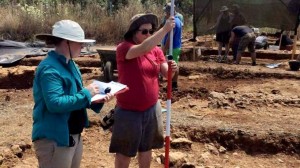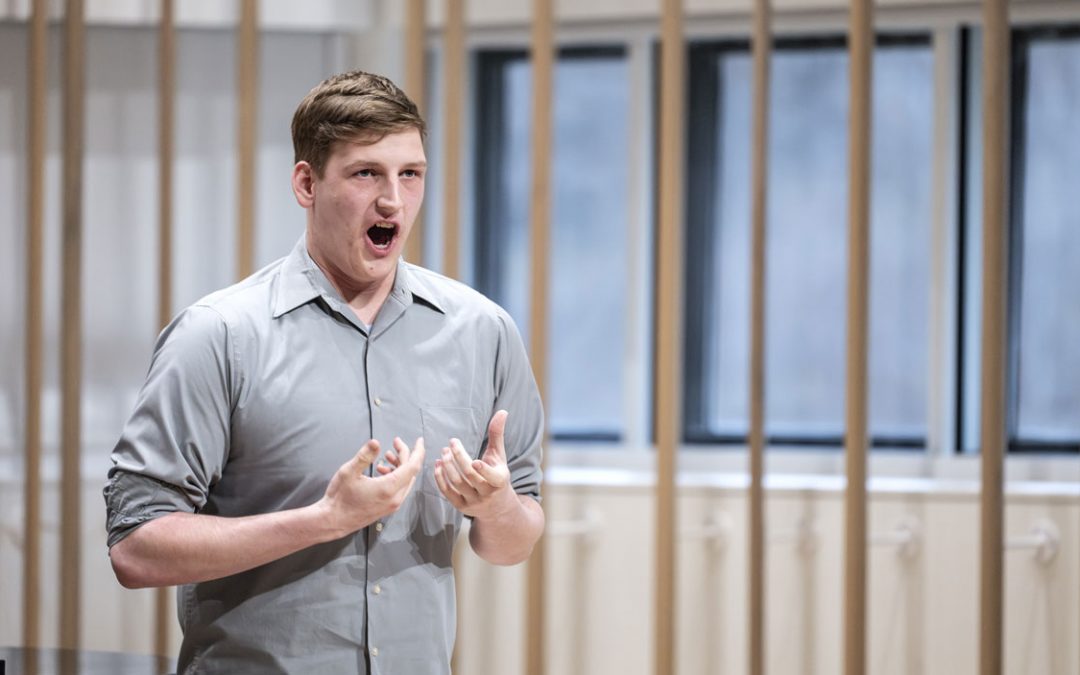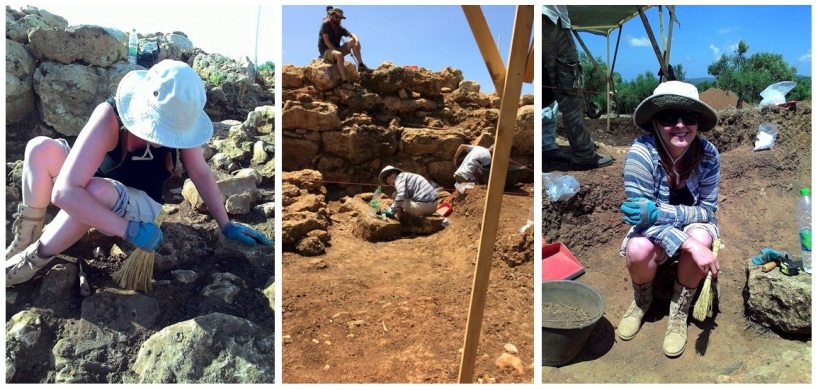
Corri Mader, one of a handful of UMSL students participating in a major archeological dig this summer in Greece, enjoys “the detail work” that excavation involves. (Photos courtesy Corri Mader and Valentina Emiliani)
Over the last three weeks, every new day has been an adventure for a group of University of Missouri–St. Louis students in Greece. And each of those days starts at the crack of dawn.
“This is my very first dig, and let me tell you, it’s no walk in the park,” said senior anthropology major Valentina Emiliani, a participant in this summer’s Iklaina Archeological Project under the direction of Professor Michael Cosmopoulos. “Our days here begin with a wake-up call at 5 a.m. and departure to the site at 6 a.m.”
Emiliani, a transfer student who was drawn to UMSL’s strong archeology program, said the excavation work continues until early afternoon, when the students get a brief respite before the night’s lectures begin. Then, following a late-evening four-course meal, the students hit the sack by 10 p.m., “and the day repeats itself.”
Emiliani and fellow students took a few moments within that intense schedule to reflect on their overseas field-school experience so far and share some thoughts with UMSL Daily readers.
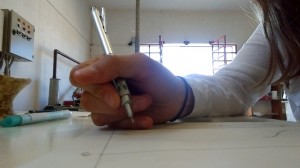
Each student spends two consecutive days in the lab working with artifacts from the excavation site.
“The excavation itself is difficult work, and I am definitely building muscles,” said Corri Mader, another senior anthropology major at UMSL. “Even so, it’s such fun. I’m having a wonderful time with my trench-mate and roommate, Jessica Engel.”
Mader and Engel helped uncover a variety of artifacts in just their first week of work at the excavation site of the Mycenaean settlement at Iklaina, once an urban center.
“We are trying to find where the rubble for the collapsed building ends,” said Engel. “So far we have found bronze nails, charcoal and mountains of pottery.”
Courtney Hayden, who expects to finish her anthropology degree at UMSL this December, said she’s learned how to distinguish various kinds of materials from rock and dirt.
“It’s super helpful to have this experience in the field, because some of these distinctions can’t be taught in a classroom. And these are good skills to have for any future work I do,” said Hayden, who is pursuing an emphasis in archeology. “Altogether, this has been a really enjoyable experience, and I would highly recommend it to anyone who has an interest in pursuing archeology or who just wants to learn how excavation works and learn some Greek history.”
Sunday excursions, following six full days of work and learning during the week, have included destinations such as Mycenae, a center of ancient Greek civilization, and the city of Olympia, where the Olympic Games originated.
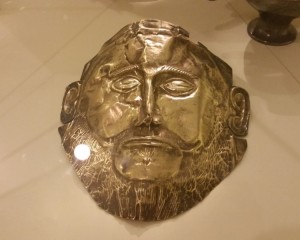
One highlight of a field trip to Mycenae, described by Homer in the “Iliad,” was seeing Agamemnon’s death mask.
“To be honest, it didn’t hit me until today’s excursion [to Mycenae] that I was in Greece, a magnificent location filled with extraordinary amounts of archeological information and history,” said Emiliani, who plans to study nautical archeology in graduate school after graduating from UMSL next spring, “specifically Viking ships.”
She noted that in addition to the experience of an actual dig, the field school provides close interaction with archeologists who specialize in different areas, ranging from ceramics to GIS to conservation and more.
“It’s truly amazing,” Emiliani said. “We not only get hands-on experience excavating, but we get to help the archeologist in the lab sort and clean artifacts. We learn how to draw artifacts, document them – there is so much that we would never have gotten from a classroom.”
Engel notes that while the manual labor and classes at night have taken some getting used to, the students are now “finding our groove.”
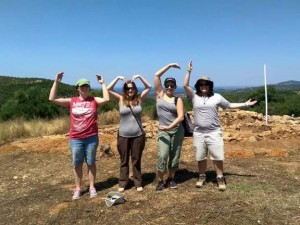
Jessica Engel, Corri Mader, Courtney Hayden and Valentina Emiliani show some UMSL pride from afar at the excavation site in Greece.
“My favorite part so far has been the new friends I have made. And the scenery here in Pylos is unbelievable. The Mediterranean Sea has the bluest water I have ever seen.”
A not-so-favorite part? The lack of a designated bathroom spot at the excavation site, admits her roommate. That and some challenging critters.
“Jessica has been heroic,” Mader said. “She’ll come out to the bush with me carrying a hoe, ready to defend me from snakes. I’d do the same for her – however, her bladder is made of tougher stuff than mine.”
One takeaway for Emiliani so far has been the value of excavation work in which artifacts do not turn up and realizing that not finding something still offers clues to the past.
“My first trench this week, we did a lot of digging and found zero artifacts,” she said. “That was a bummer – however, it does provide useful information. It could mean there is a space between buildings. My group was then moved to another trench, where we have found things: a wall, lots of pottery, teeth and bones … We’re uncovering artifacts that have not been seen for hundreds of years.”
On July 4, the mayor of Pylos, where the students were based during their time in Greece, recognized the UMSL-led excavation team for the group’s important archeological work in recent years. He emphasized the important pieces of the city’s history from 3,500 years ago that have been uncovered.
More information on the Iklaina project is available here.

